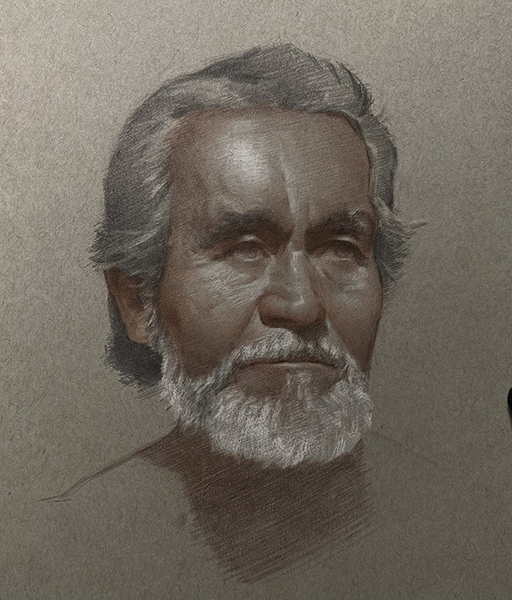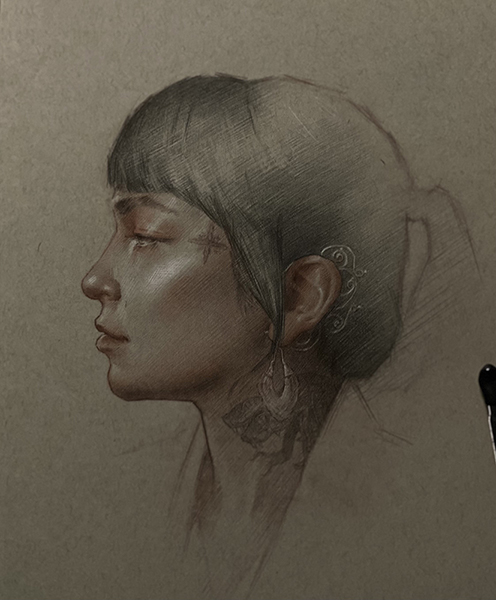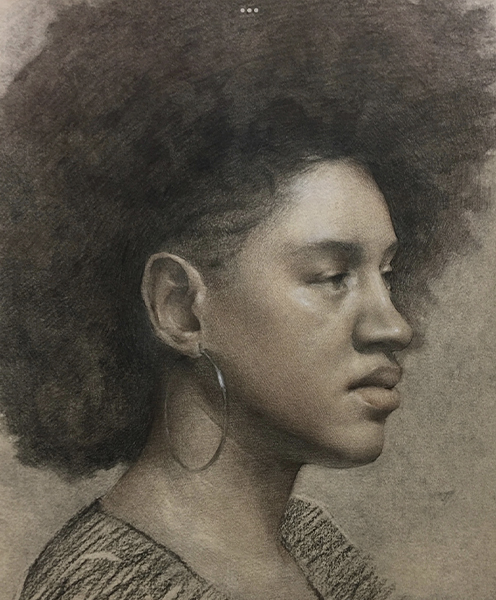The art of historical narrative using the three chalk (Red, Black, white), frequently used on toned paper has accompanied the artist since the renaissance period with its high aesthetic and practical value among masters and apprentices. In this three-day workshop artists will elaborate a portrait drawing from the live model using the technique of trois crayons on dry media paper. Artists such as Carracci, Tintoreto, Rubes, Hans Holbein, among many others used this particular technique.
The naturalistic effect followed by highly focused study of a portrait using this method will enhance the expressive sensitivity of disegno.
These three colors are used on toned paper to describe the elements of a sculptural feeling in the rendering of form adding extra attention to the studies of structure of the skull, anatomy of muscles, line, value relationships and color harmony, black used to
create the foundations of the portrait, shadows, contours and cold tones. Red used to accentuate the soft areas of tissue, muscle, and cartilage. White commonly used to describe form light and specular lights.
1. Session one
During the first day, students will start developing the block-in for the portrait focusing on the masses of light, shadows, and proportions of the facial features, studying the gesture and perspective of the pose.
2. Session two
This session is focused on interpreting the relationships between value and color, strongly pulling their drawings to a high state of development, and fixing inaccuracies of proportion.
3. Session three
This last day of the workshop is designed to finish their drawings with a highly aesthetic look, organizing all the elements of the portrait to a high quality of naturalistic effect adding the white to generate the light forms and highlights necessary.



Bio
Born in León, Mexico, in 1988 artist César Meza showed from an early age an interest in the world and the human experience through representation in drawing and painting. He began his formal training at the prestigious University of Guanajuato in the department of
visual arts, at the same time that he developed a technical formation in conservation and restoration of art. Honing his precision and attention to detail, a few projects here mentioned were, the restoration of ten 18th century paintings from the Temple of San Juan de Sahagún Salamanca, conservation and restoration of the collection of the Museum of Art and History of the state of Guanajuato, restoration of metal sculptures from the 19th century, in addition to the conservation of the bell tower, pieces dating from the 17th century belonging to the basilica of the state capital, among many other projects. One of the most recent is the conservation treatment of a fragment of a fresco from the region of Herculaneum and Pompeii from the 1st century A.D. César continues his professional relationship with galleries in Mexico City, Massachusetts & New York in the US, where he has built his formal education at the Grand Central Atelier, under the guidance of Jacob Collins, Colleen Barry, Will St. John, Edward Minnof, Anthony Baus, among others.
César has received Partial Merit Scholarships in the past, including the highest honorary scholarship to the drawing year at Grand Central Atelier. Such academy for which he formalized as a resident artist and as part of the instructors team as well, and most recently as a founder and director of a studio/atelier in Mexico city.
César Meza has lived his professional life dedicated to aesthetics and excellence within classical art, constantly changing his understanding of life in this world seeking a naturalistic representation of the human figure and nature in modern times. Pursuing the call of contemplation in search of the deep voice of beauty and comfort that surrounds him.
IG: cesarmeza.pintura